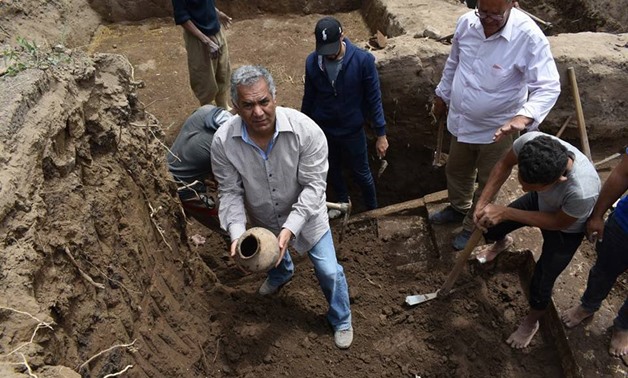
A royal celebrations hall dating back to the Ramses era was discovered at Matareya district – Ministry of Antiquities Official Facebook Page.
CAIRO – 30 April 2018: An ancient royal celebration hall dating back to the era of Ramses II was discovered at Matareya district, the Ministry of Antiquities announced on Saturday.
The Royal Celebration Hall was revealed during excavation work performed by the Ain Shams University archaeological mission headed by Mamdouh al-Damati.
“The Hall was unearthed below the soft-brick buildings and commercial residential areas that date back to the third transition period, particularly the 22nd and 23rd dynasties’ eras,” Damati recounted. The discovered hall has a rectangular floor of 2.9 m × 1.9 m, consisting of limestone tiles, rising 80 cm from the ground.
The discovered hall, which was used to hold royal celebrations such as the Jubilee feast, is considered the first of its kind in the New Kingdom era.
Damati explained that this discovery reveals that such celebrations took place in the Re Temple at this specific area. He added that the hall was discovered inside the palace used to host royal celebrations.

Damati elaborated that the mission members also unearthed a group of brick walls of a multi-story building, pointing out that it shows the three phases of construction dating back to the era of King Ramses II.
The discovered items include the main building, a layer of the third transition era and the late era, as well as the royal celebration hall.
The archaeological mission discovered a number of valuable artifacts, such as five stone blocks carved from the reign of King Ramses II, a painting of the high priests of the Sun Prince Nept Ma Raa, in addition to some pottery figures dating back to the 27th Dynasty, one of which was a small dog-shaped statue.
Damati recounted that a human amulet with a human head for a person named Thi from the Roman era is considered one of the most important pieces discovered.
“The lower part of a statue for a priest from the Ramses era was also unearthed during the digging work. It is made of alabaster, rising 20 centimeters off the ground, on a base of red porphyry stone,” Damati described in a press statement issued by the Ministry of Antiquities on Saturday.
It is worth mentioning that two important exceptional discoveries occurred on Sunday, April 22: the discovery of a marble head of Roman Emperor Marcus Aurelius in Aswan and an Osirian temple in Luxor.

The head is of Emperor Aurelius with wavy hair and beard. The Roman emperor’s head was described as rare, because in general, statues of Roman rulers are extremely scarce. The head is now located at the archaeological store; it will be subjected to restoration work and maintenance in the coming period. An Egyptian mission is currently working in Aswan to reduce the subterranean water level at Kom Ombo Temple, where the Marcus Aurelius head was discovered.
The Osirian temple was discovered at the southern side of Karnak Temples’ tenth pylon. The temple contains architectural elements of a late-period shrine dedicated to the god Osiris-Ptah-Neb.
The temple, which was found in a good state, consists of an entrance, foundation remains, columns, inner walls and ruins of a third hall located at the eastern side. The Osirian temple also houses paving stones from the shrine floor, along with other extension structures built during ancient times.
The shrine is not located on the eastern or northern side of the Amun-Re temple according to ancient Egyptian belief, which makes this discovery a highly important one. The shrine was discovered on the southern side, indicating the accuracy of the Osirian belief at that time.
Also discovered were a collection of clay pots, remains of statues and a winged frame relief decorated with offering tables bearing a sheep and goose. The relief holds the names of the kings Taharka and Tanut Amun. These two highly important discoveries were made by the Egyptian archaeological missions in Upper Egypt.



Comments
Leave a Comment